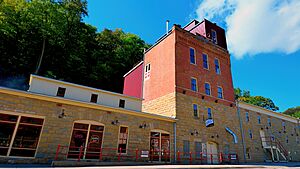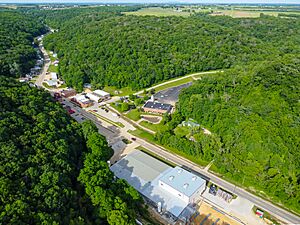Potosi, Wisconsin facts for kids
Quick facts for kids
Potosi, Wisconsin
|
|
|---|---|

Potosi Brewery
|
|

Location of Potosi in Grant County, Wisconsin.
|
|
| Country | |
| State | |
| County | Grant |
| Area | |
| • Total | 1.68 sq mi (4.34 km2) |
| • Land | 1.66 sq mi (4.30 km2) |
| • Water | 0.02 sq mi (0.05 km2) |
| Elevation | 814 ft (248 m) |
| Population
(2020)
|
|
| • Total | 646 |
| • Density | 384.5/sq mi (148.85/km2) |
| Time zone | UTC-6 (Central (CST)) |
| • Summer (DST) | UTC-5 (CDT) |
| Area code(s) | 608 |
| FIPS code | 55-64650 |
| GNIS feature ID | 1583964 |
Potosi is a small village located in Grant County, Wisconsin, United States. In 2020, about 646 people lived there. The village is part of the larger Town of Potosi.
Contents
History of Potosi
Potosi is in a special spot where Wisconsin's lead ore (a type of rock with lead in it) was found. This area is also close to the Mississippi River. The village's post office started in 1837. It moved a few times before finding its permanent home.
In 1839, three smaller settlements decided to join together. These were Snake Hollow (also called Head of the Hollow), Van Buren, and La Fayette. They formed one bigger community and named it Potosi. The post office then moved to the center of this new, combined village.
Why the Name Potosi?
There are a few ideas about how Potosi got its name, but no one knows for sure. Many mining towns around the world are called Potosi. This name often comes from the famous silver mines in Potosí, Bolivia.
Another idea is that Potosi was named after Potosi, Missouri. Many of the first lead miners in Wisconsin came from that Missouri town. A third idea, which doesn't have any proof, says it was named after "Potosa." This was supposedly the wife of Julien Dubuque, an early settler in the area.
Geography of Potosi
Potosi is a small village in terms of size. It covers about 1.67 square miles (4.34 square kilometers) in total. Most of this area, about 1.65 square miles (4.30 square kilometers), is land. A very small part, about 0.02 square miles (0.05 square kilometers), is water.
People of Potosi
| Historical population | |||
|---|---|---|---|
| Census | Pop. | %± | |
| 1880 | 466 | — | |
| 1900 | 434 | — | |
| 1910 | 464 | 6.9% | |
| 1920 | 501 | 8.0% | |
| 1930 | 447 | −10.8% | |
| 1940 | 506 | 13.2% | |
| 1950 | 556 | 9.9% | |
| 1960 | 589 | 5.9% | |
| 1970 | 713 | 21.1% | |
| 1980 | 736 | 3.2% | |
| 1990 | 654 | −11.1% | |
| 2000 | 711 | 8.7% | |
| 2010 | 688 | −3.2% | |
| 2020 | 646 | −6.1% | |
| U.S. Decennial Census | |||
The number of people living in Potosi has changed over the years. In 1880, there were 466 residents. The population grew to its highest in 1980 with 736 people. By 2020, the population was 646.
Potosi in 2010
In 2010, Potosi had 688 people living in 295 households. Most of the people were White (98.7%). A small number were Asian or Native American. About 0.6% of the population was Hispanic or Latino.
Many households (55.3%) were married couples living together. About 26.8% of households had children under 18. The average age of people in Potosi was about 45 years old.
Fun Things to Do in Potosi
Potosi is known for its history and fun events. It's home to the Potosi Brewing Company.
Potosi Brewery and Museum
The Potosi Brewery first opened in 1852 and operated until 1972. After a big restoration project, it reopened in 2008. Now, it's a museum and a brew pub where people can enjoy food and drinks. In 2015, the company opened a new facility to make more beer.
The National Brewery Museum and Library is also located at the Potosi Brewery site. It opened in 2008. This museum shows off many old items related to beer and brewing. You can see signs, advertisements, bottles, and cans from the past.
Catfish Capital and Longest Main Street
Potosi is called the "Catfish Capital of Wisconsin." Every year, usually in August, the village hosts a Catfish Festival and Fireman's Fish Fry. This event is a lot of fun. It includes a truck and tractor pull, games, fireworks, live music, and a parade. Of course, there's also a delicious fish fry!
Local road signs in Potosi proudly say that its Main Street is "the longest Main Street in the world." This claim might have started from a 1950s article in Ripley's Believe It Or Not!. That article said it was the longest Main Street without a cross street. If you look at maps today, the Main Street is about three miles long. Many smaller streets connect to it, forming T-shaped intersections, but no street actually crosses it. The street is divided into North Main Street and South Main Street.
Historic Mining Site
The Potosi Badger Huts Site is another interesting place to visit. These are old remnants from the area's lead mining history. They are listed on the National Register of Historic Places and you can reach them by a trail.
Famous People from Potosi
- William Biddlecome: A lawyer.
- Joshua B. Bradbury: A farmer, teacher, and lawmaker.
- Lafayette Caskey: A carpenter and lawmaker.
- Edward John Dorn: Served as the United States Naval Governor of Guam.
- John Lewis Dyer: A Methodist preacher who traveled a lot. He brought the gospel to Colorado in the 1860s and 1870s. He also mined lead near Potosi in the 1840s.
- Melvin Grigsby: A soldier who fought in the Union Army and the Spanish–American War. He later became the Attorney General of South Dakota.
- William Hull: A lawyer and lawmaker.
- Keith Krepfle: A professional football player.
- William Josiah MacDonald: A U.S. Representative from Michigan.
- James Wilson Seaton: A lawyer and lawmaker.
- Fred A. Thomas: A State Representative in Montana.
See also
 In Spanish: Potosi (Wisconsin) para niños
In Spanish: Potosi (Wisconsin) para niños


